1️⃣ Add/Edit knowledge
The AI Knowledge section guides you on how to connect your own content to your AI Agent (content that will be used to respond with generative answers — see Static vs. Generative Responses). You can upload documents, link websites, or add FAQ-style data, and the AI will use this information to answer user questions naturally and accurately.
It is possible to simulate similar logic using the Free Prompt or Agent modules, however you could be limited by the input token limit and there will be no auto-refresh function on data sources.

AI Knowledge with two data sources
Interface Overview
Data Sources List (1)
On the left panel, you can view and manage your data sources. You can add new data sources by clicking the ➕Add Data Source button. You can have multiple sources of the same type (e.g., several files or multiple sites) to keep things organized.
Selected Source Detail (2)
Displays the content of the selected source — in this case, a manual FAQ. Each type of source (file, sheet, website, etc.) shows different options here but you can always preview the data chunks, edit the source, set categories, and delete the content.
Toolbar (3)
The status icon tells you whether the source is up to date with the AI index. If you make any changes to your data sources, they need to be synced with the index database to be available to the AI Agent.
The 🔄️Manual Sync button lets you sync your new content with the AI Agent’s database
The 🔍Search button lets you search through your content
Open ⚙️Settings to:
Choose the language of your data sources
Set frequency of automatic updates
View the name of the Instance ID name, which is used as the Knowledge Base Index name in the Agent module (see 🤖 Agent Module | 🤖-AI-Knowledge-in-Agent)
Delete all data in the AI Agent’s database and remove category tags
The AI Knowledge data sources should be in a single language to work as intended. Responses to the user can then be translated and delivered in the language of the question (if translation is enabled in the AI Knowledge module in your dialog flow).
Types of Data Sources
Manual (FAQ)
Add question/answer pairs manually (Note: You can add more question examples for better accuracy)
Best for short, clearly defined answers
Simple to manage, great for small FAQ sets
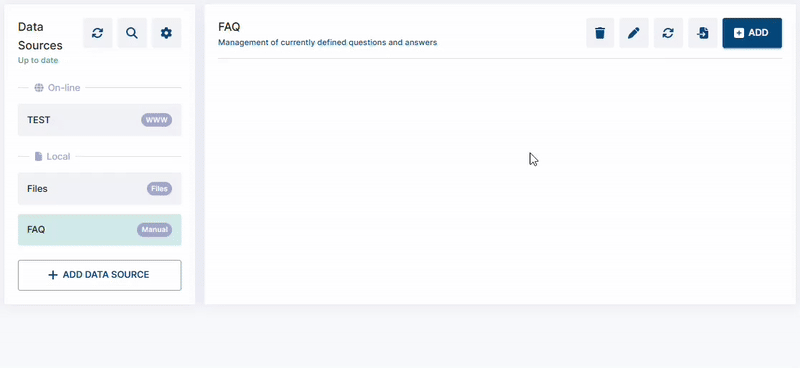
Files (.PDF, .DOCX, .TXT)
Upload and categorize documents
Good for lengthy content like policy docs, guides, contracts
Be aware that PDF parsing may be less accurate, and documents should contain text only. Images will not be converted or recognized. If you need to use a more complicated document (e.g., with tables), please contact us at support@coworkers.ai.
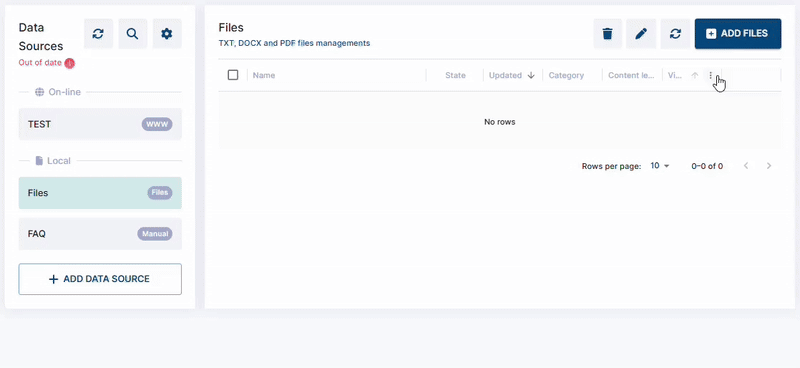
Websites (URL / XML Sitemap)
Set URL lists or XML sitemaps to pull content from your website
Use CSS selectors to hint the scraper on important content and exclude menus, footers, etc.
See more info on selectors here
The more precisely you specify the content on your website for the web scraper (using CSS selectors), the better the answers will be → less content = fewer, cleaner chunks = better answers.
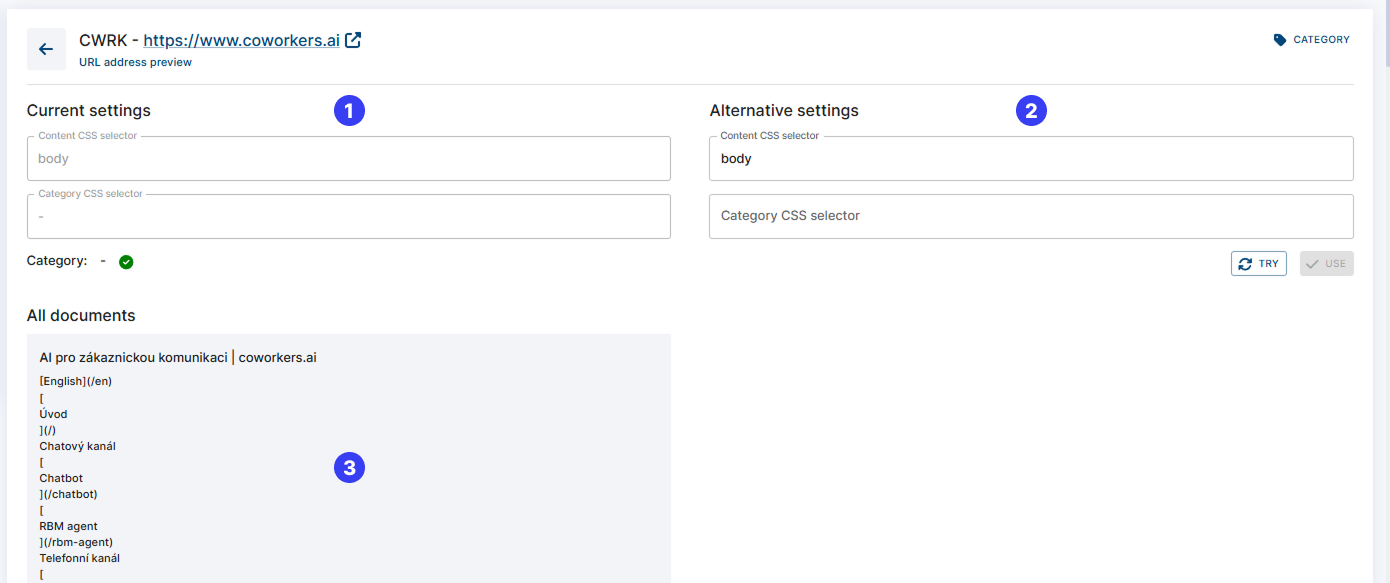
Current settings (1) shows the currently used Content CSS selector that selects which data from the website will be loaded, and the Category CSS selector (optional) that automatically assigns a category to your content based on the CSS class/id (see Categories below).
Alternative settings (2) allows you to test new selectors before saving. Add a new selector, then press the 🔄️Try button to display the newly fetched content.
Preview (3) of the content fetched from the URL. In this case, we can see a bad pattern — the CSS selector with the content is not specified, so the created chunks have no meaningful data.
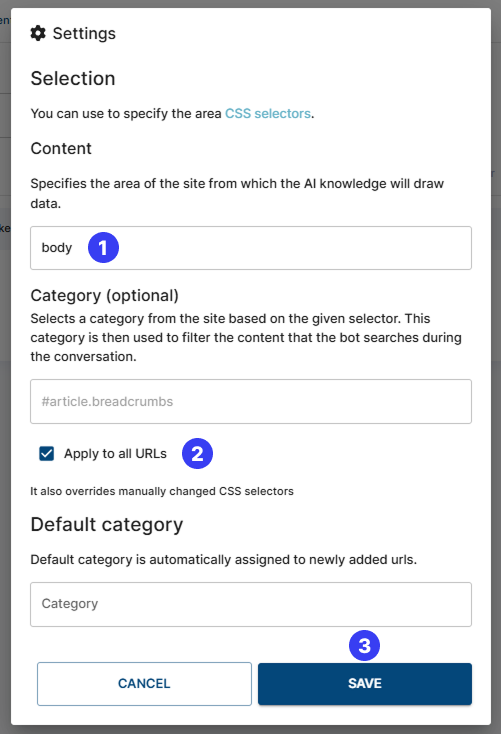
Add a selector (1), apply to all (2), save (3)
Confirming the new CSS selector setting with the ✔️Use button only affects this specific URL from the list. If you import multiple URLs, you usually need to set the same selector to all of them → navigate back to the URL list management and open Settings (top right corner) .
Tables (.CSV, .XLSX)
A Table must follow this exact column order:
question,answer,category,url(category + url are optional)Use this only for a FAQ-like content — general data tables with your format won’t work.
Google Sheets
Work identically to Tables (.CSV, .XLSX), but are connected live to Google Drive.

The only allowed format for Table sources
Confluence
To connect your Confluence space, you’ll need:
Instance URL →
https://YOUR_SITE.atlassian.net/User + Token
To create a token for a logged-in user, navigate to
Atlassian Account Management→Security-> Create and manage API tokens
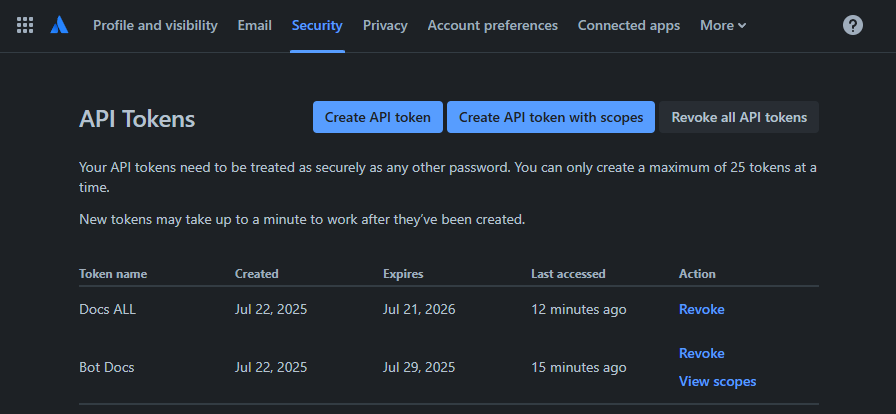
After you connect AI Knowledge to your Confluence account, you will be able to add any spaces, folders or pages you have access to:
Space: https://YOUR_SITE.attlassian.com/wiki/spaces/{space_id}
Folder: https://YOUR_SITE.attlassian.com/wiki/spaces/{space_id}/folder/{folder_id}
Page: https://YOUR_SITE.attlassian.com/wiki/spaces/{space_id}/pages/{page_id}
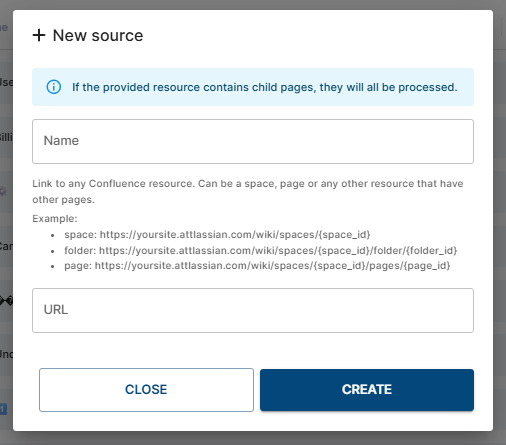
Using Categories in AI Knowledge
Categories let you tag your knowledge entries like documents, websites, and FAQs, with custom labels. Using categories gives you more control over how your AI Agent finds and delivers information.
Instead of searching your entire knowledge base every time, the AI Agent can focus only on the relevant category. This could make the responses more accurate in some cases.
Common use cases:
Focused responses within a dialog
If you’re in a part of the conversation where you only want to answer questions about, e.g., billing, you can tell the AI to only search content in the Billing category.
Smarter topic detection
Combine categories with intent detection or other logic to guide the AI Agent:
Detect topic using an intent, e.g., any “questions about invoices”
Set the category to Billing in the AI Knowledge module → it will then search only in relevant documents
🎯 The more specific the source, the more accurate the generative reply
Different content for different user types
You can avoid duplicating dialog flows by switching knowledge base categories dynamically:
If
$user_type = "company"→ use categoryBusinessIf
$user_type = "individual"→ use categoryPersonal
This is especially useful when the information is similar but slightly adjusted for different audiences.
How Categories Work in Dialogs
When using the AI Knowledge module in a dialog flow, you can search in all categories (default), include or exclude specific categories, or set them dynamically using $context. See 2️⃣ Use AI Knowledge for more details.
